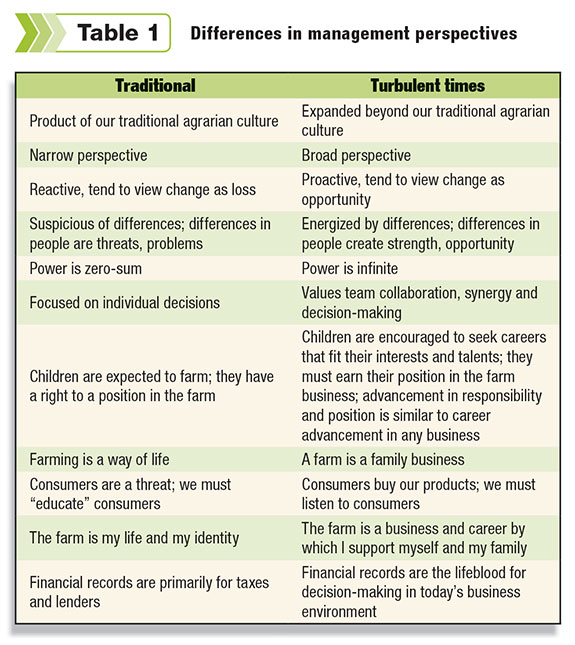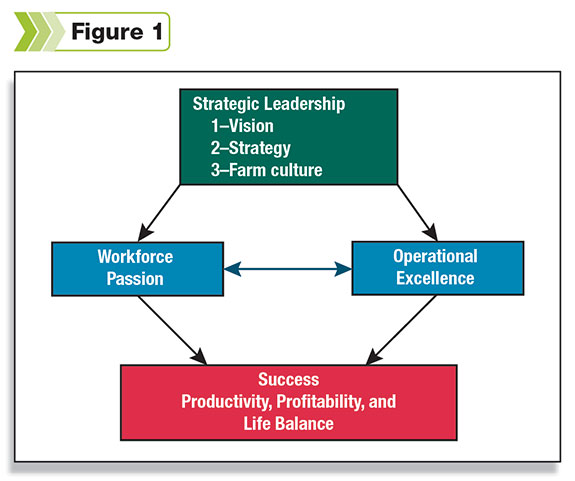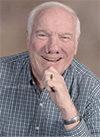In the last week, I have had three discussions about the future of professional development for farm owners and leaders. In each discussion, I have suggested that a part of their professional development in supervision, strategy and leadership should be outside of agriculture. Why would I make that suggestion?
Let’s begin by thinking about some of the major developments impacting agriculture in recent years. The following come to mind:
• The fear of dependence on imported oil, especially after 9/11, led to subsidies that enabled the development of the ethanol industry.
• Unsustainable growth in the housing industry triggered events that led to the worst recession since the Great Depression.
• Incredible advances in information and communication technologies have and will continue to change everything.
• Political, economic and climatic events and trends in parts of the world we have never heard of alter exports of agricultural products with major supply-demand implications.
The increasing interconnectedness of our global world, the increasing complexity of our dairy farm businesses and the increasing rate of change are transforming the attitudes and actions required to continue to thrive in an agricultural business.

We are all rightly proud of our rich agrarian culture.
Many of the values and features of that culture must and should be continued; others, however, must evolve as our world and our society change.
Table 1 contrasts our traditional views and the views that will enable dairy owners and leaders to continue to thrive in today’s complex and turbulent world.
How can dairy farm owners and leaders benefit from looking outside the dairy and the agricultural sector?
Below we look at what should be known about and what can be learned from outside the agricultural sector.
Understanding the world beyond the agricultural sector
The individual or individuals performing two key roles in a dairy business must be most aware of what is happening outside of the dairy and the agricultural sector. These two roles are chief executive officer (CEO) and chief financial officer (CFO).
The CEO is typically the senior leader of the dairy and the person most responsible for developing and implementing a winning business strategy. This role has changed dramatically in the last several decades as the world has globalized and the pace of business activity has exploded.
What once was often only an annual task now requires everyday vigilance. The person in this role is primarily focused on understanding the world around him or her for purposes of identifying opportunities and continual strategy adjustments.
The CFO role is generally less well understood and often absent in dairy farm businesses. An excellent definition of the CFO role is: create, implement and monitor systems that ensure our business is financially secure.
The CFO role complements the CEO role but is more focused on financial feasibility and risk management than is the CEO role. In scanning and understanding local, regional, national and global trends and events, the CFO is more focused on identifying potential threats and assessing the risks of potential strategy moves.
Let’s look at an example by looking back to 2007. Many dairy businesses expanded in this time period when milk prices were very favorable relative to input prices.
Many of these expansions were sound decisions and will prove to be wise investments – some after initial losses. These decisions were made by CEOs and CFOs of dairies with outstanding dairy performance and strong balance sheets.
Other dairies, however, made ill-timed expansion decisions. These dairies, although profitable at then-current prices, did not always have outstanding dairy performance and strong balance sheets.
In these cases it is likely the CFO role was absent or not heard. Although no one could have predicted the events leading to 2009, there were factors that if considered could have altered these decisions:
• The usage of corn for ethanol was expanding rapidly. Although no one was projecting $7 corn, the continuing shift outward of the demand curve for corn would almost certainly lead to higher feed prices.
• Several factors, including the milk-feed price ratio and dairy exports at historic highs, suggested that the likelihood of dairy profitability remaining at current levels was quite low.
• The scientific evidence that climate change is an important consideration had become overwhelming. With one of the outcomes being an increase in weather variability, and thus an increased likelihood of a year like 2012, the CFO should have been even more concerned about the impact on the expansion of a particularly adverse feed price year.
Learning from the world beyond the agricultural sector

The operational excellence component has historically been the focal point of professional development for the operation of dairy farm businesses.
Future professional development, especially for those in the CEO and CFO roles, must also focus on the workforce passion and the strategic leadership components of this structure.
The learning needs for the employee passion and strategic leadership components are in human resources, supervision, leadership, strategy and financial management (including the CFO role discussed above).
Note that these topics differ from dairy nutrition, milk quality, crop production or futures trading in that they are not unique to dairy or to agriculture.
I am not suggesting there are not excellent resources on these topics within agriculture. There are great programs and expertise in colleges of agriculture (Cornell Dairy Executives, TEPAP, local extension programs, for example), commodity organizations and private agribusinesses. These should continue to be a part of your professional development.
I am suggesting, however, that learning from outside agriculture should also become an important part of your professional development.
Let me close with three suggestions for your professional development from outside of agriculture:
1. Determine where the leaders in your community – superintendent of schools, back president, mayor, etc., – go to share leadership experiences and learning. Consider joining. It may be a service organization, such as Rotary or Lions Club, a community business organization or some other group.
2. Select some resource from the Internet to follow and review frequently. These resources include e-newsletters and webinars, which are often free.
Mine include resources from Harvard Business, Blanchard Associates, the Performance Excellence Network (a regional Baldrige organization), the local chapter of the American Association for Training and Development and the Marcus Buckingham Company.
I believe that materials from and programs organized by business schools, especially those focusing in agribusiness and family business management, will be increasingly important for the professional development of dairy CEOs and CFOs.
3. Read books on supervision and leadership. Books range from stories to complex textbooks. Please contact me at (651) 647-0495 or by email for suggestions. PD

Bob Milligan
Senior Consultant
Dairy Strategies LLC






